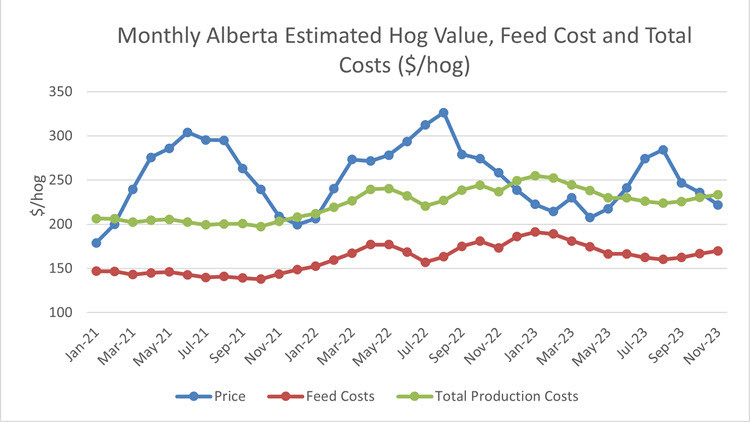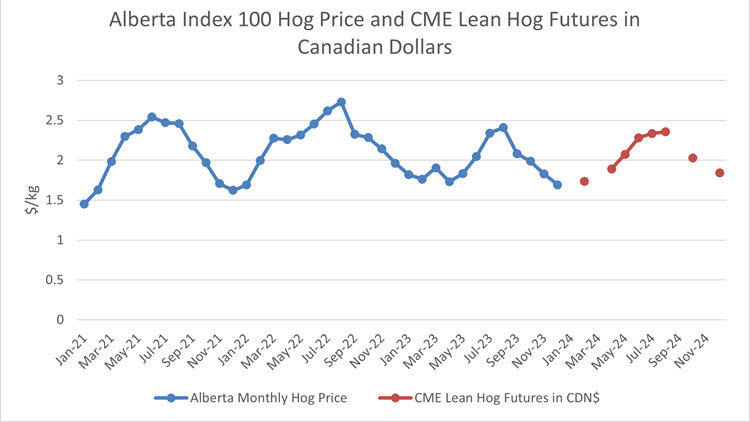Non-urgent government operations are closed December 24 to January 1, reopening January 2. View available services during this period.
See event listings and more articles in this edition of Agri-News: December 18, 2023 issue
“According to Rabobank’s annual Global Animal Protein Outlook Report, November 2023, the swine breeding herd will continue to contract in North America,” says Ann Boyda, provincial livestock market analyst with the Alberta government. “Productivity gains in terms of piglets per sow per year have seen production sustained, despite herd liquidation. Although some moderation in feed costs is evident, productivity gains have resulted in oversupply in the North American market and is putting pressure on hog prices. 2024 is predicted to be faced with continued challenges against disease and weather, tight margins and uncertain consumer sentiment.”
The Western Hog Exchange’s Weekly Regional Hog Price Report monitors national hog markets and reports that hog margins are weakening across North America. As of December 1, 2023, losses ranged from an estimated $27.81 per hog in Ontario to between $12 and $17 per hog in Manitoba. Alberta margin losses were estimated to be between $20 and $21 per hog for the same period. Quebec margins were estimated at a loss of over $24 per hog.
“In Alberta, Index 100 hog prices have been declining since August 2023. Although a price decline is seasonally expected, in combination with higher production costs, producers have been faced with a narrowing window of opportunity for annual profit. In comparison, the profitability window for 2021 and 2022 was from February to November but in 2023 this window narrowed from June to October.”
Figure 1. Monthly Alberta Estimated Hog Value, Feed Cost and Total Costs

The CME Group Lean Hog Futures can provide some insight into 2024. A hog price forecast based on the lean hog futures settlement prices for December 1, 2023, adjusted for exchange rates and United States (U.S.)-Alberta price conversion factor, pegs an average 2024 hog price at $2.07 per kilogram live weight. The conversion factor is determined by the U.S. and Canadian dressing percentages. The forecasted average price for 2024 represents a decline of 8.7% from the average for 2022, but a potential 4.5% increase over the 2023 year-to-date average hog price of $1.99 per kilogram.
Figure 2. Alberta Index 100 Hog Price and CME Lean Hog Futures

“Globally, swine herds are predicted to liquidate over the next 3 years,” explains Boyda. “Market uncertainty created by the Russian invasion of Ukraine, weather and persistent inflation are key factors. Another key driver is the rise of new legislation against livestock production. The Netherlands has implemented a buy-out scheme as part of its efforts to drastically slash nitrogen emissions, predominately nitrogen oxide and ammonia, by 50% by 2030. New Zealand’s government has also introduced a targeted carbon tax on gases produced by farm animals, starting in 2025. Denmark, a major hog producing country, has set targets for greenhouse gas emissions reduction of 55% to 65% by 2030. Stricter regulations result in higher production costs. Financial losses lead to less production.”
In the U.S., animal production legislation regulating sale of product raised with specified space allotment, such as Proposition 12 in California and new Massachusetts regulations, affect the Canadian pork industry. Some firms like duBreton based in Quebec and Maple Leaf Foods have made the transition to open sow housing to meet regulatory requirements. California is a key market for Alberta pork representing $97.295 million in 2022, nearly 56% of all Alberta pork exports to the U.S. Proposition 12 goes into effect on January 1, 2024.
The North American pork market is highly interdependent. In 2022, the U.S. was Alberta’s second largest pork export market valued at nearly $175 million, following Japan at $196.5 million. Mexico comes in third valued at $66.8 million. Alberta’s live hog and pork export value year-to-date (January to October 2023) is estimated at $22.1 million and $291.9 million, respectively. This year-to-date estimate reflects a 20.2% and 40.1% decline, respectively, over the same period 2022. Factors that contributed to lower export values include the weaker consumer pork demand, uncertainty caused by the new production regulations and the deteriorating hog price.
“With lower pork production globally, there still is hope for stronger prices but unfortunately the pork industry may need to ride out some tough times before they arrive,” says Boyda. “Alberta’s pork sector is known for its quality and innovation and must continue to prove its fair treatment of animals and adherence to sound practice in defense of market regulatory challenges.”
Contact
Connect with Ann Boyda for more information:
Phone: 780-422-4088
Email: [email protected]
Sign up for Agri-News
Start every Monday with the week’s top agricultural stories and latest updates.
Read about all things agriculture at Alberta.ca/agri-news